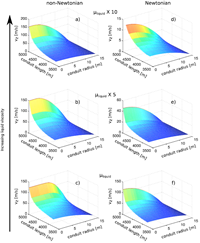Non-Newtonian flow of bubbly magma in volcanic conduits
Colucci S., P. Papale, C.P. Montagna (2017).
Journal of Geophysical Research – Solid Earth, 122/3, 1789–1804, doi: 10.1002/2016JB013383.
Abstract
The dynamics of magma ascent along volcanic conduits toward the Earth’s surface affects eruptive styles and contributes to volcanic hazard. The rheology of ascending magmatic mixtures is known to play a major role on mass flow rate as well as on pressure and exit velocity at the vent, even determining effusive versus explosive eruptive behavior. In this work we explore the effects of bubble-induced non-Newtonian rheology on the dynamics of magma flow in volcanic conduits. We develop a quasi 2-D model of magma ascent that incorporates a rheological constitutive equation describing the strain-dependent effect of gas bubbles on the viscosity of the multiphase magma. Non-Newtonian magma flow is investigated through a parametric study where the viscosity of the melt and the water content are varied over natural ranges. Our results show that non-Newtonian rheology leads to greater exit velocity, mass flow, and density. The pressure distribution along the conduit remains very similar to the Newtonian case, deviating only at the conduit exit. Plug-like velocity profiles develop approaching the conduit exit, when mixture velocity is high, and are favored by smaller liquid viscosity. Since the mass flow rate, the density and the velocity of the mixture exiting from the conduit are fundamental for quantifying and assessing the transport and emplacement dynamics, neglecting that the non-Newtonian effect of bubble-bearing magmas may result in misinterpretation of the deposit and, consequently, eruptive behavior.
http://onlinelibrary.wiley.com/doi/10.1002/2016JB013383/full


